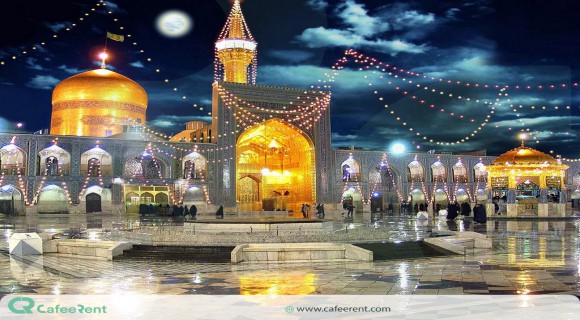Yalda night is the year's longest and darkest night.

On the shortest night of the year, Iranians celebrate Yalda night by assembling in groups and partaking in poetry readings up until midnight.
The Iranians' method for dealing with the coldest time of the year is called Shab-e Yalda (Yalda's night) or Shab-e Chelle. This Iranian holiday has a very long history and is one of the most significant Iranian festivals and ceremonies. It is observed annually on the night of December 20/21 (1) in the Gregorian calendar.
Shab-e Yalda's origins can be traced to Zoroastrian tradition when people needed to take precautions against evil because it was the longest and darkest night of the year. And what better way to celebrate this longest night than by coming together and spending it with your loved ones?
Some people believe that this event is older than 7000 years. But Shab-e Yalda was formally incorporated into the ancient Iranian calendar by Darius I in the year 502 BC. Yalda is derived from a Syriac word that means "Birth" in English.
It is a name that is very odd for a date when darkness rules the night for the longest period of time during the year, yet it is also full of significance and optimism at the same time.
In fact, ancient people, including Aryan tribes from India and Iran, Europe, and Asia, realized that the shortest days occur in the final days of autumn and that the first night of winter marks the birth of the Sun (Mehr) and the start of the year.
As a result, they called this night the birth of the Sun (Mehr). Some people think that this idea also serves as the foundation for Christian Christmas.
Shab-e Yalda is a lovely ritual with a rich history and fascinating background that can also be used in modern-day settings.
Since ceremonies and rituals have been a part of human life since the beginning, maintaining and engaging in them can give us a sense of purpose and a connection to nature and the central ideas of life.
There are some guidelines you should abide by if you want to celebrate the longest night of the year in the same way that Iranians do. Would you like to know what those guiding principles are? Continue reading if so!
Where did Yalda originate from?

The little boy's initial thought might be, "What does the name Yalda imply and where did it come from? "
Some Christians from Syria went to Iran in the first and third centuries to escape religious persecution. Along with them, they brought their own language and traditions. One of these traditions and holidays was the celebration of the birth of their prophet, Jesus Christ, on the twenty-first day of December.
They also gave this day the name Yalda, which in their language denoted childbirth. Because of the parallels between Iranians celebrating the winter solstice and these Christians commemorating the birth of their Prophet, the name "Yalda" became widely used among Iranians to refer to their celebration as well as welcome those Christians and their rituals and traditions.
It's also important to note that the Arabic term Yelda means "black night," and since Persian and Arabic share many vocabulary ad cultural practices, it's possible that this name refers to the entire idea of this customary Persian holiday.
How is Shab-e Yalda observed in Iran?
A delightful aspect of Yalda Night is eating. On this particular night, Iranians consume almonds, watermelons, and pomegranates while sharing the last of the summer's fruits. Shab-e-Yalda fruits also have symbolic meanings.
Because of its spherical shape, some people think that watermelon represents the sun, while others think that eating watermelon protects one from contracting winter illnesses. Pomegranate is another fruit that represents new life, and its vivid crimson seeds stand in for the light of life.
Reading poetry from the Divan-e-Hafiz (Fal-e Hafiz) is a fun Yalda Night custom. The eldest member of the family or group of friends chooses a poem at random from the book and reads it aloud. Each member of the family or group of friends expresses a wish while keeping it a secret.
It is entertaining to analyze the poetry and make educated guesses about other people's wishes because it is thought that the poem represents the want and the way it would be fulfilled. Thus, the final and longest night of fall joyfully ends, and the first wonderful day of winter begins.
In 2008, Shab-e-Yalda and its customs were formally included on Iran's List of National Treasures due to how entertaining and fascinating they are. While they share similar traditions, Yalda Night is also observed in nations like Afghanistan, Uzbekistan, Tajikistan, and Turkmenistan, as well as in several Caucasian republics like Azerbaijan and Armenia.
Delicious Food, Is an Essential Part of Yalda Night!

Eat as much as you can is the first rule! Although it may sound funny, it is somehow true. You're going to talk and chat up until well after midnight, lengthening the night.
So, to keep yourself entertained, you'll need lots of great food and treats! On this night, people also consume fruits and nuts in addition to sweets and pastries.
Pomegranates and watermelons are particularly significant fruits. Without consuming these 2 fruits, a true Yalda cannot be observed.
All of these things, along with others, are put on a korsi in a fairly traditional version (a type of low table found in Iran, with a heater underneath it which people sit around). In certain places, it's usual to serve forty different kinds of food during the Yalda night celebration! So be ready for the longest night of the year with a fantastic dinner and the best treats!
RED color
As much as you can, use red decor and candles. The color red, which can be found in watermelons and pomegranates, represents the dawn's crimson tones and the radiance of life. Our chilly,
drawn-out night is given passion and life by the warmth of this color. Using this vibrant hue to create your table is essential. Candles are also crucial since they illuminate our lengthy night.
THE DIVAN-E HAFEZ
Purchase a Hafez book since it is one of the cornerstones of an authentic Yalda in Iran. In Iran, almost every family has at least one "Divan-e Hafez" but never three or four! Make a "Fal" out of this book, that's what you ought to do.
Fal is consulting the bok and using Hafez's odes as a form of divination. What you need to do is ask Hafez for advice and support by making a request or asking a query regarding your present love or life issue in your heart.
The poem that appears when you open the Divan (Hafez's poetry book) at random would be his response to your query.
Obviously, you need a book with the translations in it or someone Iranian standing by who can translate it for you.
The oldest family member, typically a grandfather, opens the book and reads the poem to each member of the family. Because some people find Hafez's responses to be highly realistic and can easily relate to them, it is actually a fun exercise. So, if you plan to celebrate Yalda with Iranians, get your copy of Hafez as soon as you can!
Is it Shabe Chelleh or Yalda Night?

Nowadays, the terms Yalda and Chelleh are interchangeable when referring to this unique night of festivity. What does Chelleh imply and represent, though?
Iranians split the year into seasons, each of which has a name that translates to "forty days" and is called a separate chelleh. The first chelleh occurs in the summer; the others, known as the great and tiny Chelleh, occur in the winter.
The small Chelleh, which begins from the tenth to the thirty-first day of Bahman (the second month of winter in the Persian calendar), contains twenty nights and days that are added to create the second forty-day period, the small Chelleh.
The big Chelleh begins on the first day of Dey, the first month of winter in the Persian calendar, and lasts for forty days.
Thus, the traditional Iranian festival of the winter solstice known as Shabeh Chelleh and Yalda Night—which is still observed by Iranians and other nations such as Azerbaijan, Afghanistan, Iraqi Kurdistan, Tajikistan, and Turkey—is the same as Yalda Night.
Why do they have a party this evening?

On the final night of fall, which would be December 21 according to the Georgian calendar, our fictitious young kid is now in Tehran, at the residence of the Tehrani folks. He is eagerly awaiting the chance to inquire about the reason they commemorate this night.
Iranians love to share their culture and heritage, and Yalda is first and foremost a night of celebration, therefore they respond to him with smiles and pleasant expressions.
Zoroastrianism was practiced by the people of ancient Iran. Darkness is connected to evil in Zoroastrian beliefs. Even though it only lasts for a minute, the night of the last day of fall is regarded as the longest night of the year.
Ancient Iranians would spend this longest night of the year with friends and family in order to stop evil from triumphing. They would have fun and stay up until dawn.
The festival's ultimate goal—celebrating the sun's birth, the light, and warmth—was accomplished when the sun rose on the first day of winter. And this is where the word Yalda, which means "birth," comes into its own.
Even though Iranians were no longer Zoroastrians, the Yalda night or Shabe Chelleh celebration was always remembered. Life is valuable in Iranian culture and tradition. Iranians celebrate life whenever they have the chance.
Darkness still evokes negative emotions of evil and loneliness in Iranian culture, as it might in other cultures as well. The sun and light, on the other hand, stand for life and happiness. Iranians commemorate the triumph of light over darkness for this reason.
Life's Beauty: Yalda Night
A deity by the name of Mithra formerly inhabited ancient Iran. She warmed people's hearts and was the goddess of light. Yalda's nighttime celebration is thought to be an ode to her, who restores light to the populace's lives. Ancient Iranians appreciated and welcomed the privilege of having an extra minute of light each day.
Experiencing an ancient culture's traditions of valuing life, togetherness, light, warmth, respect, and happiness is a joyous journey for both an adult and a little boy who has grown up in a world of unique adventures.
conclusion
Yalda night is one of the most beautiful nights that you can find in the tradition of Iran and the different provinces of Iran. But how can you visit all over Iran? You can visit the https://cafeerent.com/tourism website and rent a car to travel all over Iran and enjoy it.







Add Comment